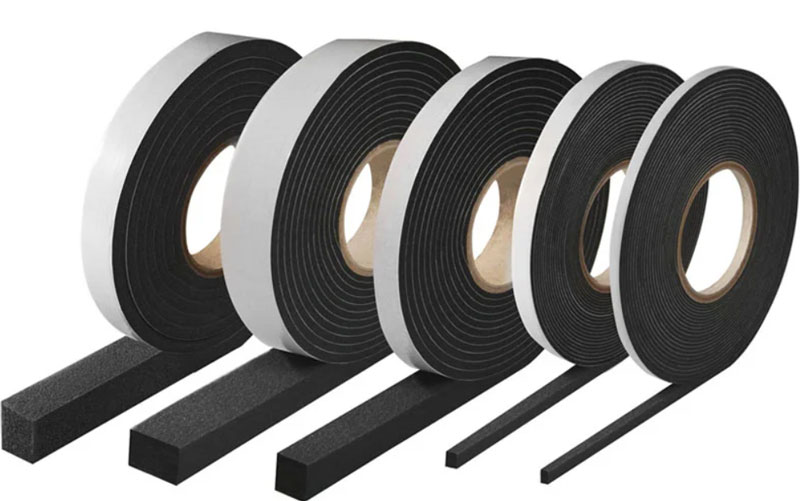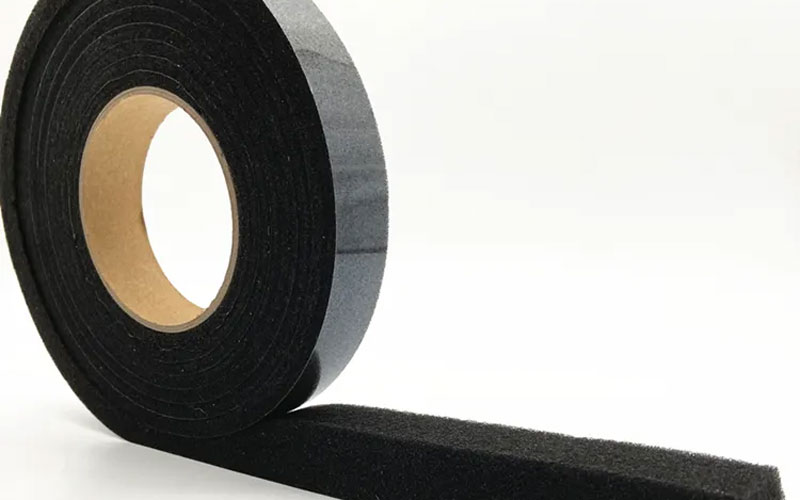Choosing an expanding foam tape is a process that requires comprehensive consideration of multiple factors, especially in different application scenarios, where product performance requirements vary greatly. Expanding foam tape is widely used in construction, electronics, automobiles, furniture and other fields.
With its good elasticity, cushioning performance and strong bonding ability, it has become an important material in industry and life. In order to ensure that the foam tape can play the best effect in use, it is particularly important to choose the right product. Here Toptape will introduce in detail how to choose expanding foam tape from multiple dimensions.

1. Material type
The base materials of expanding foam tape are diverse, mainly including EVA foam, PE foam, PU foam, PVC foam, etc.
- EVA foam is widely used in applications that require high elasticity and shockproof functions because of its excellent elasticity, shock resistance and cushioning properties.
- PE foam is lightweight and water-resistant, and is often used for sound insulation and heat insulation of electronic equipment.
- PU foam performs well when fitting curved or irregular surfaces due to its softness and high resilience, and is suitable for scenes with high requirements for deformation and resilience.
- PVC foam is commonly used in the construction and automotive industries due to its good chemical resistance and fire resistance.
Therefore, when choosing high-elastic foam tape, you must first clarify the material type and decide which substrate to choose based on the specific use environment.
2. Adhesive type
Adhesive is a key component of foam tape, and its type directly affects the bonding strength and durability of the tape. Common adhesives include acrylic adhesive, rubber adhesive and silicone adhesive.
- Acrylic adhesive has strong weather resistance and aging resistance and is suitable for long-term outdoor use. Rubber adhesive has strong initial adhesion and is suitable for applications that require quick bonding, especially in indoor environments.
- Silicone has excellent high and low temperature resistance and is suitable for use in environments with large temperature changes. Therefore, choosing the right adhesive type according to the actual application scenario can ensure that the foam tape maintains a good bonding effect during use.

3. Thickness and density
The thickness and density of the foam tape are also factors that cannot be ignored when choosing. Thickness and density determine the elasticity and compressive resistance of the foam.
- High-density foam tapes are usually stronger and suitable for applications with greater pressure, such as fixing automotive parts.
- Low-density foam tapes are more elastic and suitable for applications that require good cushioning and shock absorption, such as cushioning materials in electronic products.
- The thickness of the foam is also one of the key factors in the selection. Thicker foams usually have better cushioning effects, while thinner foams are more suitable for applications with small spaces.
So when choosing high-elastic foam tapes, you need to choose tapes with appropriate thickness and density according to specific pressure and cushioning requirements.
4. Temperature resistance
The operating temperature range of high-elastic foam tapes is different, so it is particularly important to choose the right temperature resistance. In some special environments, foam tapes may be exposed to extreme temperatures, so it is necessary to ensure that they have sufficient high or low temperature resistance.
- For example, in the engine compartment of a car, the tape may need to withstand high temperatures, so it is necessary to choose high-temperature resistant foam tapes.
- In some low-temperature environments, foam tapes need to have good low-temperature resistance to ensure that they do not lose elasticity and adhesion at low temperatures.
- Therefore, when choosing foam tape, its temperature requirements in the actual use environment must be fully considered to ensure that it can still maintain good performance under extreme temperatures.
5. Waterproof and corrosion resistance
Foam tape may be exposed to humid or corrosive environments in some application scenarios, and its waterproof and corrosion resistance are particularly important at this time.
- For example, in outdoor buildings and car exteriors, foam tapes may need to face the erosion of rain, moisture and chemicals, so they must have good waterproof and chemical corrosion resistance.
- In these environments, choosing foam tapes with waterproof and chemical resistance can ensure that it maintains its bonding effect for a long time without failing due to environmental factors.

6. UV resistance
For foam tapes exposed to sunlight for a long time, UV resistance is also a factor that needs to be paid attention to when choosing. Ultraviolet rays have a significant effect on the aging of the tape, which will cause the performance of the tape to deteriorate or even fail. Therefore, choosing foam tapes with good UV resistance can extend its service life, especially in outdoor scenes such as construction and automobile assembly.
7. Bonding time and durability
In some applications, bonding time and durability are important factors affecting selection. Quick bonding ability is very important for improving production efficiency, while the durability of the tape affects its stability in long-term use.
In an environment that requires efficient production, a foam tape that bonds quickly can save time and improve the operating efficiency of the production line; in situations where the bonding effect needs to be maintained for a long time, a foam tape with strong durability can ensure the long-term stability of the bonding.
8. Processability
In actual use, the processability of the foam tape is also an important factor to consider when choosing. Good processability means that the foam tape can be easily cut, die-cut, etc. to meet the needs of different shapes and sizes.
For example, in the manufacture of electronic products, foam tapes often need to be cut to precise sizes to match specific components, so having good processability can greatly improve work efficiency and ensure fit.

There are many factors to consider when choosing high-elastic foam tape, including the type of substrate, adhesive selection, thickness and density, temperature resistance, water resistance, corrosion resistance, UV resistance, bonding time and durability, processability, etc.
Then you can ensure that the selected foam tape can perform better in actual applications, so as to meet different application requirements. If you have any questions in specific applications, please contact the professional foam tape supplier for consultation-Toptape!





